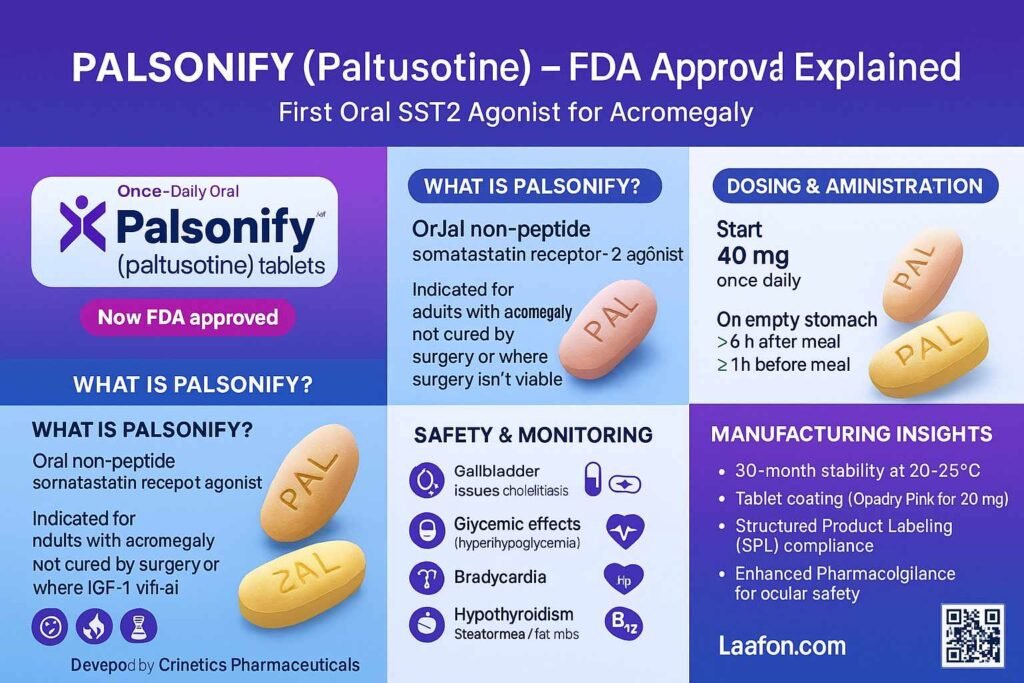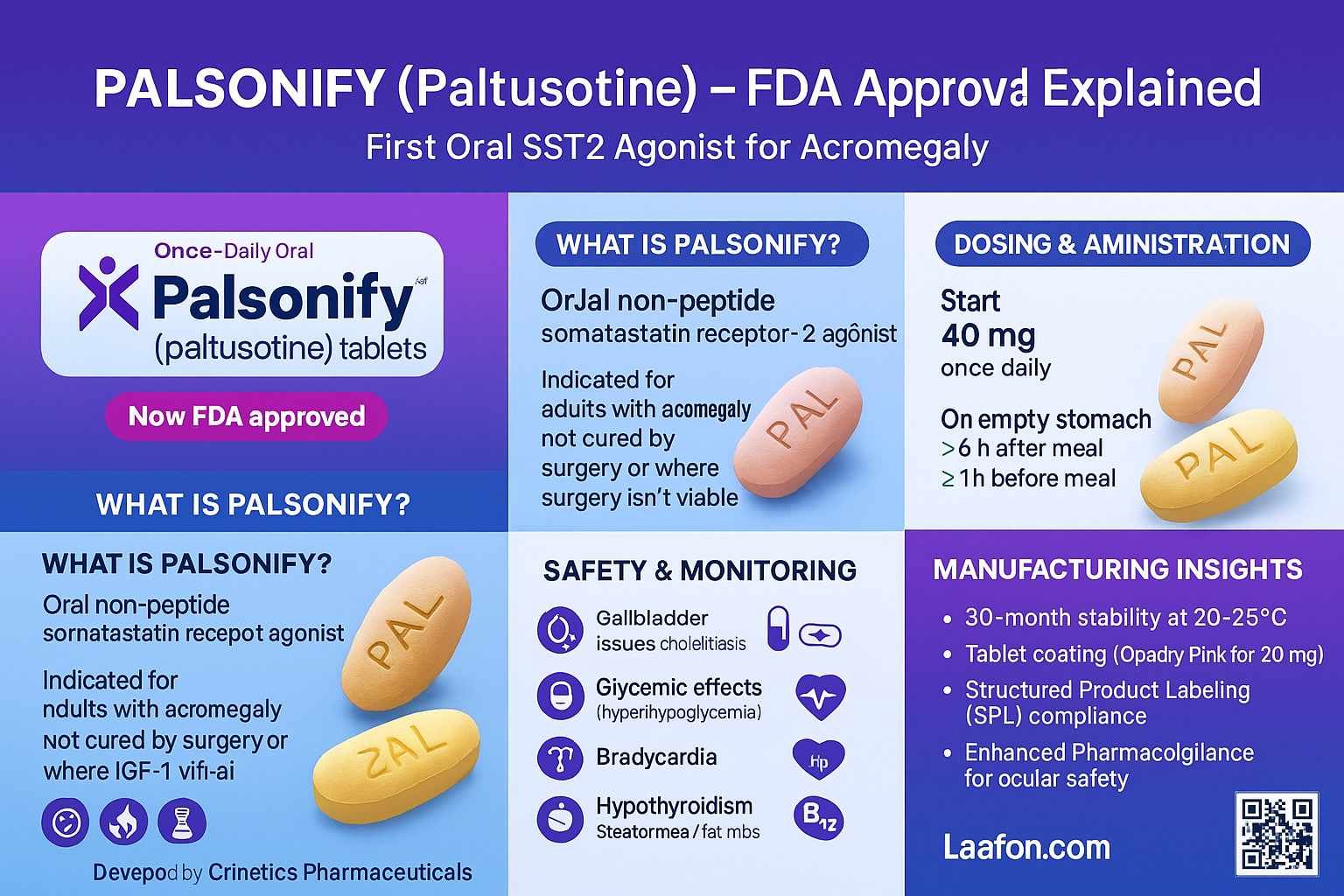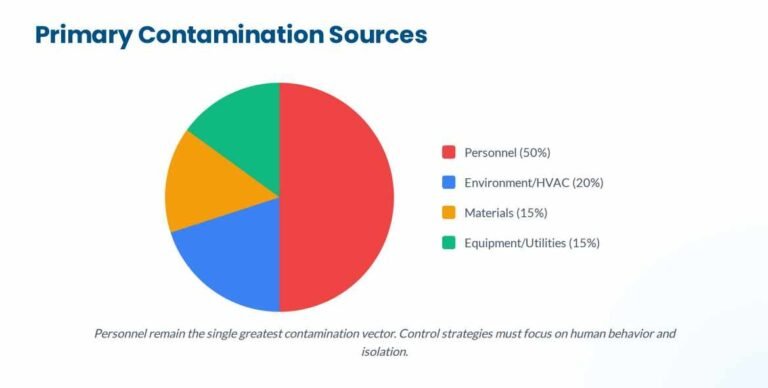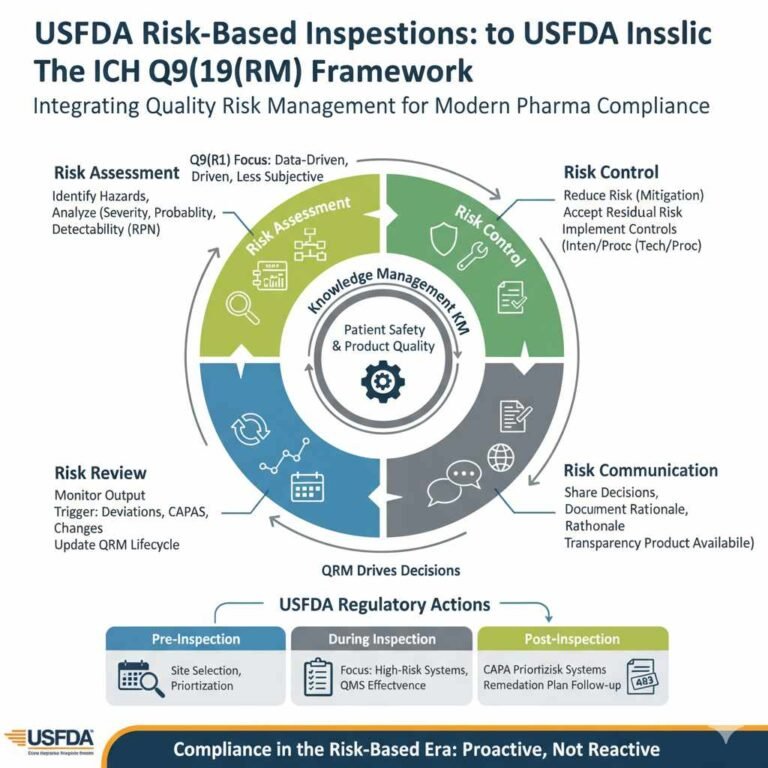Acromegaly, a rare endocrine disorder caused by excess growth hormone (GH), has posed immense challenges in clinical management. For decades, patients with inadequate surgical response or inoperable cases relied on complex regimens of injectable somatostatin analogs. PALSONIFY (paltusotine), newly approved by the FDA in September 2025, ushers in a new era with its innovative, once-daily oral therapy. This post delivers an authoritative, evidence-based look at PALSONIFY’s approval process, clinical impact, mechanism of action, safety, and broader regulatory context, meeting and exceeding standards set by leading medical and pharmaceutical publications.[1]

The FDA Approval: Key Facts & Process
- Date Approved: September 25, 2025
- Sponsor: Crinetics Pharmaceuticals Inc.
- Indication: Treatment of adults with acromegaly who had an inadequate response to surgery and/or for whom surgery is not an option.
- Classification: New Molecular Entity (NME); orphan drug designation.
- Dosage Forms: Oral tablets, available in 20 mg and 30 mg strengths.
- Route: Once daily, orally, on an empty stomach.
Approval Highlights
The approval was based on comprehensive evidence from two pivotal Phase 3 clinical trials, nonclinical studies, product quality assessments, and labeling compliance. The application received a standard review, as sufficient medical options for acromegaly exist; no advisory committee was required due to a lack of controversy in the submission. PALSONIFY is exempt from pediatric requirements due to its orphan drug status.[219070Orig1s000AdminCorres.pdf+2]
Clinical Evidence: What Sets PALSONIFY Apart?
Mechanism & Innovation
PALSONIFY is a highly selective somatostatin receptor 2 (SSTR2) agonist. It suppresses both GH and IGF-1 secretion, mimicking the natural hormone somatostatin but with exceptional selectivity (>4000-fold at SSTR2). This targeted approach allows for oral administration and improved patient adherence.[219070Orig1s000ChemR.pdf+1]
Phase 3 Studies: Robust Efficacy
- Study 1: Enrolled 111 adults with biochemically uncontrolled acromegaly, either treatment naïve or previously treated. 24 weeks of oral PALSONIFY resulted in 56% achieving IGF‑1 normalization, compared to 5% on placebo. Most achieved control within 2–4 weeks and sustained it through the study.
- Study 2: 58 adults previously controlled on injectable somatostatin analogs. After switching to oral PALSONIFY, 83% maintained IGF‑1 normalization at 36 weeks, versus 4% for placebo.
- Symptom Relief: Patients on PALSONIFY also reported lower severity in common acromegaly symptoms (headache, joint pain, fatigue, swelling) versus placebo.[219070Orig1s000AdminCorres.pdf]
Key Dosing Information
- Initiation: 40 mg once daily, can be temporarily reduced to 20 mg for tolerability.
- Titration: After 2–4 weeks, based on IGF‑1 response, titrate to 60 mg once daily.
- Administration: On an empty stomach (at least 6 hours after last meal, 1 hour before next meal).219070Orig1s000AdminCorres.pdf
Safety Profile: Adverse Events & Monitoring
PALSONIFY’s safety profile reflects its somatostatin analog class, but in oral form, easing administration and monitoring. Key points from clinical and regulatory data:
Common Adverse Events (≥5%):
- Diarrhea
- Abdominal pain
- Nausea
- Decreased appetite
- Sinus bradycardia
- Hyperglycemia
- Palpitations
- Gastroenteritis
Serious/Monitorable Events:
- Cholelithiasis (gallstones), sometimes leading to cholecystitis or pancreatitis
- Blood sugar abnormalities (hyper/hypoglycemia, diabetes)
- Cardiovascular events (bradycardia, conduction abnormalities)
- Thyroid function changes (hypothyroidism)
- Steatorrhea and fatty stools, suggesting pancreatic insufficiency
- Vitamin B12 deficiency
Regulatory Safety Controls:
- Routine glucose, thyroid, and vitamin B12 monitoring
- Patient counseling for signs of gallbladder and metabolic complications
- Enhanced pharmacovigilance requested by FDA for ocular risks (macular degeneration, retinal changes), especially post-marketing.219070Orig1s000ChemR.pdf+1
Drug Interactions & Use in Special Populations
Drug-Drug Interactions:
- Strong/Moderate CYP3A4 inducers and proton pump inhibitors can lower paltusotine exposure, requiring potential dose adjustments.
- PALSONIFY may lower cyclosporine exposure, necessitating cyclosporine dose changes and monitoring.219070Orig1s000AdminCorres.pdf
Special Populations:
- Pregnancy: No adverse effects at multiples of therapeutic doses in animal study; limited human data.
- Pediatric: Use not established—no requirement due to orphan designation.
- Geriatric: No dose adjustment needed for elderly.
- Hepatic Impairment: No dose adjustment required for mild to severe liver dysfunction; modest variation in drug exposure.219070Orig1s000AdminCorres.pdf
Product Quality, Manufacturing, and Labeling
Quality Review:
- Immediate release, spray-dried dispersion tablets (20 and 30 mg strengths).
- All excipients meet compendial standards; no novel excipients.
- Manufacturing process supports solubility for oral use.
- Stability studies grant a 30-month shelf life at 20–25ºC.
- Biopharmaceutical assessment confirms rapid in vitro dissolution (Q at 20 minutes), with adequate bridging to commercial batches.
Labeling Compliance:
- All FDA recommendations for container, carton, patient counseling, and prescribing information met.
- Storage, child-resistant packaging, and ingredient disclosure follow current regulatory standards.[219070Orig1s000ChemR.pdf]
Why PALSONIFY is a Game-Changer
- First-in-class Oral Somatostatin Analog for Acromegaly: Offers meaningful progress beyond injectable treatments, promoting greater patient convenience.
- Effective in Both Treatment-Naïve and Previously Treated Patients: Demonstrated rapid, sustained IGF-1 normalization.
- User-Friendly Dosing and Monitoring: The once-daily pill is a significant shift for patients, with precise monitoring guidance for healthcare providers.
- Regulatory Thoroughness: Approval journey reflects careful FDA scrutiny—ensuring product quality, safety, manufacturing controls, and ongoing risk management (including enhanced pharmacovigilance).
What Should Clinicians and Patients Know?
For Clinicians:
- Monitor for gallbladder, cardiac, thyroid, and metabolic complications per label.
- Counsel on key adverse reactions and drug interactions.
- Report and analyze ocular events per FDA enhanced pharmacovigilance protocol.
For Patients:
- Take exactly as directed—on an empty stomach, with water.
- Watch for and report unexpected abdominal, blood sugar, cardiac, or thyroid symptoms.
- Store medication in original, child-resistant container, within recommended temperature range.
Post-Approval Considerations & Future Directions
The FDA’s request for post-marketing safety reporting (especially on ocular symptoms) highlights ongoing vigilance as PALSONIFY becomes widely available. Additionally, the approval includes a feedback mechanism: Crinetics Pharmaceuticals may request a post-approval meeting to discuss the application process and communication—setting a positive precedent for future biopharma launches.
FAQ
What is PALSONIFY, and how does it work to treat acromegaly?
PALSONIFY (paltusotine) is the first once-daily oral somatostatin receptor agonist approved for treating adults with acromegaly who have not responded to surgery or for whom surgery is not possible. It works by selectively binding to somatostatin receptor subtype 2 (SSTR2), inhibiting the secretion of growth hormone (GH) and insulin-like growth factor-1 (IGF-1). This mechanism supports the normalization of elevated hormones that cause acromegaly symptoms, offering a modern alternative to injectable drugs.
What clinical evidence supported PALSONIFY’s FDA approval?
PALSONIFY’s approval was based on results from two pivotal Phase 3 studies. In one, 56% of adults with uncontrolled acromegaly achieved IGF-1 normalization after 24 weeks with PALSONIFY, versus 5% who received placebo. Another study showed that 83% of previously controlled patients maintained their IGF-1 levels using PALSONIFY instead of monthly injectable analogs, compared to only 4% with placebo. Both trials demonstrated rapid efficacy, sustained hormone control, and relief from symptoms such as headache, fatigue, and joint pain.
What are the most common side effects of PALSONIFY?
Most common side effects (≥5%) observed in clinical trials include diarrhea, abdominal pain, nausea, decreased appetite, bradycardia, hyperglycemia, palpitations, and gastroenteritis. Serious but less common risks include gallstones, pancreatitis, blood sugar changes, thyroid dysfunction, steatorrhea, and vitamin B12 deficiency. Routine monitoring for glucose levels, thyroid function, and vitamin B12 is recommended for patients taking PALSONIFY.
Is PALSONIFY more convenient than injectable treatments for acromegaly?
es, PALSONIFY’s oral, once-daily dosing significantly improves convenience over injectable somatostatin analogs, which often require monthly or more frequent injections at a healthcare facility. This ease of administration can improve treatment adherence, patient satisfaction, and overall quality of life—making it a major advancement in acromegaly management.
Who should not use PALSONIFY, and what precautions are required?
PALSONIFY should not be used by patients with known hypersensitivity to paltusotine or any tablet excipient. Caution is advised in those with a history of gallstones, cardiac conduction disorders, diabetes, or thyroid disease. Clinicians should monitor patients’ blood sugar, thyroid function, and vitamin B12 regularly, and advise on early reporting of abdominal pain or changes in vision, as post-marketing vigilance for ocular symptoms is ongoing.
Conclusion
PALSONIFY’s FDA approval represents a breakthrough for acromegaly management—broadening the therapeutic landscape with a well-tolerated, effective oral treatment supported by robust clinical, regulatory, and quality data. As real-world experience accumulates and post-marketing data emerge, PALSONIFY is poised to set a new standard for rare disease therapeutics, fulfilling a critical unmet medical need with both rigor and innovation.[1]
Reference
- NDA Approval Letter: Palsonify FDA Approval Letter
[https://www.accessdata.fda.gov/drugsatfda_docs/appletter/2025/219070Orig1s000ltr.pdf] - Prescribing Information/Labeling: Palsonify Full Prescribing Information PDF[ https://www.accessdata.fda.gov/drugsatfda_docs/label/2025/219070s000lbl.pdf]
- Product Quality Review: NDA Product Quality Review PDF
[https://www.accessdata.fda.gov/drugsatfda_docs/nda/2025/219070Orig1s000ChemR.pdf] - FDA Novel Drug Approval Database (2025): FDA 2025 Novel Drug Approvals Page
[https://www.fda.gov/drugs/novel-drug-approvals-fda/novel-drug-approvals-2025] - NDA Administrative Correspondence & Clinical Study Data:
NDA Administrative Correspondence PDF
[https://www.accessdata.fda.gov/drugsatfda_docs/nda/2025/219070Orig1s000AdminCorres.pdf]
Disclaimer: This blog provides an expert-level, evidence-based overview and does not substitute for official prescribing information or regulatory guidance. Always consult healthcare professionals and official documents for clinical decisions.




